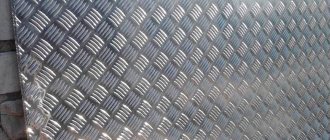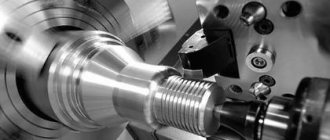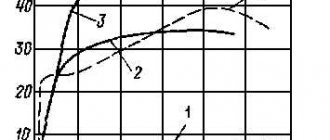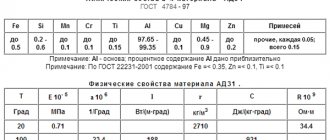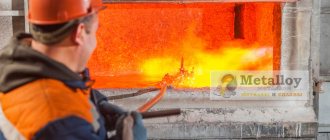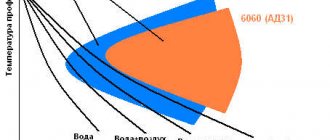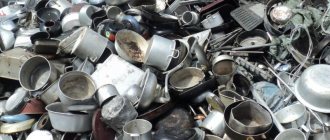Brief designations:σв— temporary tensile strength (tensile strength), MPaε— relative settlement at the appearance of the first crack, %σ0.05— elastic limit, MPaJк— ultimate torsional strength, maximum shear stress, MPaσ0.2— conditional yield strength, MPaσben— ultimate bending strength, MPa δ5,δ4,δ10— relative elongation after rupture, %σ-1— endurance limit during bending test with a symmetrical loading cycle, MPaσco0.05 And σcom— compressive yield strength, MPaJ-1— endurance limit during torsion testing with a symmetrical loading cycle, MPaν— relative shift, %n— number of loading cycless in— short-term strength limit, MPaR And ρ— electrical resistivity, Ohm mψ— relative narrowing, %E— normal modulus of elasticity, GPaKCU And KCV— impact strength, determined on a sample with concentrators of the types U and V, respectively, J/cm 2T— temperature at which properties were obtained, degreess T— proportionality limit (yield strength for permanent deformation), MPal And λ— thermal conductivity coefficient (heat capacity of the material), W/(m °C)HB— Brinell hardnessC- specific heat capacity of the material (range 20 o - T), [J/(kg deg)]H.V.— Vickers hardnesspn And r- density kg/m 3HRСе— Rockwell hardness, scale CA— coefficient of thermal (linear) expansion (range 20 o - T), 1/°СHRB— Rockwell hardness, scale Bσ t T— long-term strength limit, MPaHSD- Shore hardnessG— modulus of elasticity during torsional shear, GPa
_ _ _ _ _ _ _ _ _ _ _ _ _ _ _ _ _ _ _ _ _ _ _ _ _ _ _ _ _ _ _ _ _ _ _ _ _ _ _ _ _ _ _ _ _ _ _ _ _ _ _ _ _ _ _ _ _ _ _ _ _ _ _ _ _ _ _ _ _ _ _ _ _ _ _ _ _ _ _ _ _ _ _ _ _ _ _ _ _ _ _ _ _ _ _ _ _ _ _ _ _ _ _ _ _ _ _ _ _ _ _ _ _ _ _ _ _ _ _ _ _ _ _ _ _ _ _ _ _ _ _ _ _ _ _ _ _ _ _ _ _ _ _ _ _ _ _ _ _ _ _ _ _ _ _ _ _ _ _ _ _ _ _ _ _ _ _ _ _ _ _ _ _ _ _ _ _ _ _ _ _ _ _ _ _ _ _ _ _ _ _ _ _ _ _ _ _ _ _ _ _ _ _ _ _ _ _ _ _ _ _ _ _ _ _ _ _ _ _ _ _ _ _ _ _ _ _ _ _ _ _ _ _ _ _ _ _ _ _ _ _ _ _ _ _ _ _ _ _ _ _ _ _ _ _ _ _ _ _ _ _ _ _ _ _ _ _ _ _ _ _ _ _ _ _ _ _ _ _
Source: metallicheckiy-portal.ru
MARKING OF ALUMINUM ALLOYS
Technical aluminum
Primary aluminum is produced according to GOST 11069-2001.
Primary aluminum marking
| Brand | Chemical composition | |||
| Al | Fe | Si | Impurities, no more | |
| Special purity | ||||
| A999 | 99,999 | — | — | 0,001 |
| High purity | ||||
| A995 | 99,995 | 0,0015 | 0,0015 | 0,005 |
| A99 | 99,99 | 0,003 | 0,003 | 0,01 |
| A97 | 99,97 | 0,015 | 0,015 | 0,03 |
| A95 | 99,95 | 0,03 | 0,03 | 0,05 |
| Technical purity | ||||
| A85 | 99,85 | 0,08 | 0,06 | 0,15 |
| A8 | 99,8 | 0,12 | 0,12 | 0,2 |
| A7 | 99,7 | 0,16 | 0,16 | 0,3 |
| A6 | 99,6 | 0,25 | 0,2 | 0,4 |
| A5 | 99,5 | 0,3 | 0,3 | 0,5 |
| A0 | 99,0 | 0,5 | 0,5 | 1,0 |
High purity aluminum is used in the production of semiconductor devices and for research work. High purity aluminum is used for cladding parts of electrical and radio equipment. Technical purity aluminum is used for the preparation of aluminum alloys, the manufacture of wires, and gaskets.
After deformation of semi-finished products (receiving sheets, plates, strips, strips, profiles, panels, rods, pipes, wires, stampings and forgings), technical aluminum receives the designation AD (deformed aluminum). The numbers after the AD marking also indicate the percentage purity of the alloy as a percentage.
It is more convenient to use digital marking. The principle is outlined below for alloys.
If in aluminum intended for the production of wrought Al-Mg alloys, the Na content
“E” - in brands with guaranteed electrical characteristics.
Alloys
For domestic aluminum alloys, alphanumeric and numeric designation systems are used. There is no system laid down in the alphanumeric marking (although these alloys were later assigned a digital marking, but it did not “take root”). The letters can symbolize aluminum and the main alloying component - AMts (Al-Mn), AMg1 (Al-Mg), the purpose of the alloy ( AK6, AK4-1 - forging aluminum), the name of the alloy ( AV - avial, D16 - duralumin), can be associated with the name of the institute that developed the alloy ( VAD1, VAD23 - VIAM - All-Russian Institute of Aviation Materials, wrought aluminum), etc. The numbers after the letters do not reflect the chemical composition.
At the end of the sixties, four-digit digital marking was introduced. The first number indicates the base of the aluminum alloy. Aluminum and alloys based on it are marked with the number “1”. The second digit indicates the main alloying component or main alloying components. The second number “0” denotes various grades of aluminum, sintered aluminum alloys (SAS), various grades of aluminum foam. The number “1” denotes alloys based on the Al-Cu-Mg system; number “2” - alloys based on the Al-Cu system; number “3” - alloys based on the Al-Mg-Si system; number “4” - alloys based on the Al-Li system, as well as alloys alloyed with poorly soluble components, for example, transition metals (manganese, chromium, zirconium); alloys marked with the number “5” are based on the Al-Mg system and are called magnalium; alloys based on the Al-Zn-Mg or Al-Zn-Mg-Cu systems are designated by the number “9”. Numbers 6, 7 and 8 are reserved.
In the Russian Federation, GOST 4784 “Aluminum and wrought aluminum alloys. Marks." provides marking of alloys in three ways: both in alphanumeric form and only in digital form, as well as taking into account the requirements of the international standard (international marking) ISO 209-1 (ISO 209-1 Wrought aluminum and aluminum alloys -Chemical composition and forms of products -Part 1: Chemical composition). At the same time, the digital marking according to GOST does not coincide with the international marking of aluminum alloys.
Digital marking of wrought aluminum alloys
| Brand | Group of alloys, main alloying system |
| 1000-1018 | Technical aluminum |
| 1019, 1029, etc. | Powder alloys |
| 1020-1025 | Foamed aluminum |
| 1100-1190 | Al-Cu-Mg, Al-Cu-Mg-Fe-Ni |
| 1200-1290 | Al-Cu-Mn, Al-Cu-Li-Mn-Cd |
| 1300-1390 | Al-Mg-Si, Al-Mg-Si-Cu |
| 1319, 1329, etc. | Al-Si, SAS powder alloys |
| 1400-1419 | Al-Mn, Al-Be-Mg |
| 1420-1490 | Al-Li |
| 1500-1590 | Al-Mg |
| 1900-1990 | Al-Zn-Mg, Al-Zn-Mg-Cu |
Designations of wrought alloys
To designate wrought aluminum and wrought aluminum alloys, an international four-digit digital system is used:
Table 1
First digit
The first digit “1” indicates a series of grades of technical aluminum.
The sign by which an aluminum alloy belongs to one of the series from 2xxx to 8xxx is the alloying element with the maximum average (nominal) content. The exception is the alloys of the 6xxx series, in which the main predominant feature is the ratio of magnesium and silicon content, which are available for the formation of magnesium silicide Mg2Si.
If several alloying elements have the same maximum average content in the alloy, then the selection of the series is made in the order of the series: copper, manganese, silicon, magnesium, magnesium silicide, zinc.
Second digit
In aluminum grades of the 1xxx series, designations that have a second digit from 1 to 9 indicate special control of one or more individual impurities.
In alloys of series from 2xxx to 8xxx, the second digit in the alloy designation indicates the modification of the alloy. If the second digit is zero, then this indicates the original, base alloy. Numbers from 1 to 9 indicate, respectively, the modification of the base alloy.
Third and fourth digits
The 1xxx series includes unalloyed aluminum with a natural level of impurities. The last two digits (10xx) are used to indicate the minimum permissible aluminum content in various versions of unalloyed aluminum. They are usually called aluminum grades.
These last two digits coincide with the last digits of the minimum aluminum content, which is specified to the nearest 0.01%. For example, with an aluminum content of at least 99.80%, the aluminum grade is designated 1080.
The last two digits in the designations of alloys of the 2xxx to 8xxx series do not have any physical or chemical meaning, but simply identify the various alloys within the group.
Additional letters
Sometimes the letter A is added at the end of the four digits of the designation, which indicates the modification of the alloy. For example, alloy 6063A is a modification of alloy 6063.
Alloy condition
The full designation of a wrought aluminum alloy for finished products, in addition to the designation of the alloy, must include its condition, for example, 6063-T6.
Casting alloys
Aluminum-based casting alloys are generally marked with two letters. The second letter indicates the element from which the alloy is derived. For example, “ AK ” – aluminum-silicon system, “ AM ” – aluminum-copper, “ AMg ” – aluminum-magnesium, “ AMts ” – aluminum-manganese, etc. Then comes a number indicating the content of the element. If the alloy is alloyed, indicate the letter designations of the elements and their content:
For example, AK12M2 is an alloy of the aluminum-silicon system, with a silicon content of 12% (on average) and copper 2%. AMg4K is an aluminum-magnesium system containing 4% magnesium and 1% silicon.
If the cast aluminum alloy is thermally hardened, a heat treatment designation is placed at the end of the mark (GOST 1583-93):
T1 – artificial aging without pre-hardening;
T5 – hardening and short-term incomplete artificial aging;
T6 – hardening and complete artificial aging;
T7 – hardening and stabilizing tempering;
Marking based on the principle AL + numbers indicating the conventional brand number, for example AL9, is outdated, although it is still often found in technical documentation.
Source
How to choose the brand of aluminum alloy for your products.
Details Published 01/16/2016 10:03
In this article we will consider the issue of choosing a grade of aluminum alloy from the point of view of further decorative processing of products made from this material.
There are a large number of grades of aluminum alloy, which are divided into two main types: cast and wrought . Cast alloys include AL and AK type alloys (for example AL4, AL9, AL33, AL19, AK9, AK5, etc.), which in turn are divided into groups based on the formation of systems (for example aluminum-silicon, aluminum-silicon-copper, aluminum-magnesium, aluminum-copper). Deformable alloys include alloys of the AD, AMG, AMts, D type (AD0, AD1, AMg5, AMg6, D16, D18, etc.) they are divided according to strength properties (according to one of the types of properties): soft, alloys of moderate strength and high strength. The variety of grades of aluminum alloys is large and complex, so their description will be very capacious; suffice it to say that all alloys have their own unique chemical composition and, as a result, the content of certain alloying elements in the alloy affects its physical properties.
If it is necessary to carry out anodizing processes, the choice of material grade is one of the key points if products need to be given a decorative appearance using this treatment. The main role in this case is played by the chemical composition of the alloy, because the content of certain components may adversely affect the appearance of the products. So, for example, cast alloys (or silumins) with a high silicon content in their composition practically do not “give in” to anodizing and coloring; this results in the formation of a loose and thin anodic film that cannot be painted in dye solutions. Unfortunately, it is for these reasons that many owners of cars and motorcycles are unable to carry out external transformations of certain components of their vehicles. However, there are processes that make it possible to anodize silumins, but they are so complex, expensive and rare that one can say “virtually absent”.
For grades of wrought alloys , the content of some elements that are introduced to improve mechanical and anti-corrosion properties may be too high and the anodic film acquires various shades and defects:
A high iron content can lead to the formation of a gray precipitate and black stripes on products, manganese - to a brown tint of the film, magnesium and zinc to a dark gray tint, chromium to a yellow tint of the film, and a high titanium content to a decrease in the brightness of the anode film. When anodizing and painting in light tones, these defects can be significant, however, when painting black, these defects become less noticeable.
It is worth mentioning products made from sheet material. Regardless of the brand of material, most “aluminum metal”, which comes in the form of sheets, is applied by the manufacturer with a so-called cladding layer (cladding is coating the surface with a thin layer of pure aluminum) to create additional anti-corrosion protection. In this case, an additional letter “A”, “B” or “U” appears in the alloy code (for example D16 AT, AMg6BM) which informs about the thickness of the cladding layer: 2-4%, 1.5%, 4-8%, respectively (percentage of the thickness sheet). Due to the peculiarity of applying this layer to metal, when anodizing it is not always possible to achieve the required color of the products (they come out several tones lighter than the required one), variations in color may appear in the form of spots or color transitions. It is also worth saying that polishing such sheet material can also lead to stains.
All of the above is of great importance when carrying out decorative anodizing, however, when applying an anodic film for technical needs, this in no way affects the properties of the applied film.
And as recommendations for choosing the brand of aluminum alloy for anodizing with further painting for your products, we can offer the following:
— for the manufacture of parts with a mirror finish, aluminum grades A99, A97, A95 or A7 can be used. The surface of parts made of aluminum grades A6, AD1 or aluminum alloys AMg3, AD31, AD33 has a slightly lower shine.
- for the manufacture of parts that do not require a shiny surface, deformable aluminum alloys can be used (for example, V95, D16, AMts or their analogues)
— when choosing the Amg6 brand (due to the peculiarity of the chemical composition), painting can only be done in black.
— to create a matte surface (in particular for a black matte surface), the parts must be sandblasted (the best result is achieved by sandblasting with corundum).
When choosing a grade of aluminum for parts, you must keep in mind that the purer the chemical composition of the aluminum, the higher the quality of the finish.
Source: alumodec.ru
Aluminum grades
Issues discussed in the material:
- What are the different grades of aluminum?
- Primary aluminum grades
- Brands of technical aluminum
- Grades of deformable aluminum
- Cast aluminum grades
- Aluminum grades for deoxidation
- Grades of aluminum and its alloys
- Main grades of aluminum and its alloys (in table)
- Aluminum sheet grades
It is difficult to imagine modern industry without aluminum and its alloys. And therefore it is so important to know which grades of this metal are used for certain purposes. For example, the types used for the construction of the fuselage of a spacecraft are not suitable for the production of food utensils, etc.
Aluminum marking is used to indicate the percentage of various impurities, as well as the production or enrichment technology. Let's figure out what physical and chemical properties certain grades of this metal have and where they are used.
Application of aluminum
Jewelry
In the distant past, due to the high cost of aluminum, it was used to make jewelry. Thus, scales with aluminum and gold bowls were presented to D. I. Mendeleev in 1889.
When the cost of aluminum decreased, the fashion for jewelry made from this metal passed away. But even today it is used to make jewelry. In Japan, for example, aluminum is used to replace silver in the production of national jewelry.
Cutlery
Aluminum cutlery and cookware continue to be popular. In particular, aluminum flasks, pots and spoons are widely used in the army.
Glass making
Aluminum is widely used in glass making. High reflectivity and low cost of vacuum deposition are the main reasons for using aluminum in the manufacture of mirrors.
Food industry
Aluminum is registered as a food additive E173. It is used as a food coloring and also to preserve food from mold. E173 colors confectionery products in a silver color.
Military industry
Due to its light weight and low cost, aluminum is widely used in the manufacture of small arms - machine guns and pistols.
Rocketry
Aluminum and its compounds are used as rocket fuel in two-component rocket propellants and as a combustible component in solid rocket propellants.
Aluminum energy
In the aluminum energy industry, aluminum is used to produce hydrogen and thermal energy, as well as to generate electricity in air-aluminum electrochemical generators.
Source: ferrolabs.ru
The most common aluminum alloys
Most aluminum items are actually made from aluminum alloys. The mechanical strength of pure aluminum, as a rule, is not enough to solve even the simplest household and technical problems.
Adding alloying elements to aluminum significantly changes its properties. Some qualities increase - strength, hardness, heat resistance. Others decrease - electrical conductivity, corrosion resistance. Density almost always increases as a result of doping. The exception is alloying with manganese and magnesium.
According to the method of application, aluminum alloys can be divided into wrought and cast alloys. Deformable alloys have high ductility when heated. Foundry - capable of effectively filling foundry molds.
The raw material for producing alloys of both types is not only technically pure aluminum, but also silumin - an alloy of aluminum with silicon (10-13%). Silumin in Russia is usually labeled as SIL-00 (the purest in terms of impurities), SIL-0, SIL-1 and SIL-2 and is supplied in the form of smooth ingots or ingots with pinches weighing 6 and 14 kg.
Their structure (homogeneous solid solution) provides the greatest plasticity and the lowest strength during pressure treatment under heat. The main alloying elements are copper, magnesium, manganese and zinc. In small quantities - silicon, iron, nickel, etc. Wrought aluminum alloys are usually divided into hardenable and non-hardenable. The strength of the former can be increased by heat treatment.
Typical hardenable alloys are duralumin - alloys of aluminum with copper (2.2 - 7%) containing impurities of silicon and iron. They can be alloyed with magnesium and manganese.
The names of duralumin brands consist of the letter “D” (it is always the first) and the alloy number. Nowadays, there are five main grades of duralumin that are most common:
Source: tdsm.ru
Primary aluminum grades
An example of this group is primary aluminum grade “A5”. To obtain it, enriched alumina is used. It is impossible to find the metal in its pure form in nature, since it has high chemical activity.
When interacting with other elements, the metal forms bauxite, nepheline and alunite. Subsequently, these ores are used to produce alumina, and then, through certain chemical and physical reactions, pure aluminum.
We recommend articles on metalworking
The requirements that grades of primary aluminum must meet are established in GOST 11069. Marks indicating that a metal belongs to a certain class are vertical and horizontal stripes applied to the workpieces with indelible paint of certain colors. Primary aluminum is used in leading industrial fields, mostly in those where increased technical characteristics of the raw material are required.
Brands of technical aluminum
In grades of technical (unalloyed) aluminum, the content of foreign impurities is no more than 1%.
According to GOST 4784-97, grades of technical aluminum must have increased anti-corrosion resistance. However, their strength is not very high. The absence of alloying elements in the metal leads to the formation of a stable protective oxide film on its surface.
Distinctive features of grades of technical aluminum are high thermal and electrical conductivity. The molecular lattice is distinguished by the almost complete absence of impurities that scatter the flow of electrons. Such properties allow the metal to be used in such areas as instrument making, the manufacture of equipment for heating and heat transfer, and lighting.
Pure aluminum
Industrial unalloyed aluminum - technically pure aluminum - contains aluminum from 99.80 to 99.00%. Unalloyed aluminum has relatively low strength and therefore has limited use as a structural material. The exception is when good electrical conductivity, ease of processing and high corrosion resistance are important. Pure aluminum does not have the ability to be thermally hardened. However, the strength properties of pure aluminum can be increased by cold hardening, that is, cold plastic deformation.
Pure aluminum has poor casting properties, so it is used mainly in the form of products that are produced by metal forming methods.
Grades of deformable aluminum
Various grades of aluminum are processed hot and cold by rolling, pressing, drawing, etc. Plastic deformations make it possible to obtain workpieces with different longitudinal profiles: aluminum rods, sheets, strips, plates, profiles, etc.
The requirements for deformable grades of aluminum are set out in GOST 4784, OCT1 92014-90, OCT1 90048 and OCT1 90026. A distinctive feature of the metal is the solid structure of the solution, which contains a large percentage of eutectic - a liquid phase in equilibrium with two or more solid states of matter.
Grades of deformable metal are widely used in industries such as aircraft and shipbuilding, construction (for welding), i.e. in areas that require increased technical characteristics of materials.
Chemical composition and condition
Pure aluminum is a rather weak structural material with a tensile strength of about 90 MPa. However, when small amounts of alloying elements such as manganese, silicon, copper, magnesium or zinc are added to aluminum, as well as appropriate heat treatment and/or after cold plastic deformation, the tensile strength of aluminum - or an aluminum alloy - can reach 700 MPa.
Many aluminum alloys have wide ranges of mechanical and physical properties depending on the type of their state. They obtain these states as a result of technological processing of an aluminum product, both thermal and deformation. These wide ranges of properties of aluminum alloys provide the opportunity for a wide selection of just such an aluminum alloy that would maximize the specified properties at a minimum cost.
Cast aluminum grades
Shaped products are made from casting grades of aluminum, the characteristic properties of which are high specific strength combined with low density. Thanks to these features, it is possible to manufacture (cast) parts of various configurations without the appearance of cracks.
There is a division of foundry metal grades into groups according to their purpose. They are:
- highly hermetic (“AL2”, “AL9”, “AL4M”);
- high-strength and heat-resistant (“AL19”, “AL5”, “AL33”);
- corrosion-resistant.
To improve the properties of parts made from these types of aluminum, various heat treatment methods are used.
Grades of aluminum and its alloys
There is a division of aluminum alloys into:
- deformable (used for forging and rolling);
- foundry (for casting parts).
The requirements for their chemical composition are defined in GOSTs 1131 and 4784-97.
Depending on the type of hardening, alloys can be:
- heat-strengthened;
- hardened by pressure.
More common is another classification, which is based on the characteristics of the alloys. According to it, heat-strengthened alloys are divided into:
- heat-resistant (“AK4”, “AK4-1”, “D20”, “1201”);
- high-strength (“B93” and “B95”);
- highly plastic medium strength, or aviali, alloyed with aluminum, magnesium and silicon (“AD33”, “AD31” and “AD35”);
- welded with normal strength (“1925” and “1915”);
- duralumin with normal strength, alloyed with aluminum, copper and magnesium (“D16”, “D1” and “D18”);
- forging (“AK8” and “AK6”).
Thermally non-hardening steels with increased corrosion resistance and weldability are divided into:
- highly plastic of medium strength, called magnalia (“AMg1”, “AMg6”, “AMg2”, etc.);
- highly plastic, low strength, alloyed with magnesium (“D12” and “AMts”), and unalloyed, or technical aluminum (“AD1” and “AD0”).
When manufacturing sheets, the requirements of GOST 21631–76 must be observed. Products are classified depending on the area of application and properties:
- Acid-resistant grades of aluminum sheet are used to produce fuel tanks, welded containers, aircraft components, rivets, frames and automobile radiators. The metal is characterized by good weldability and corrosion resistance, increased ductility and deformability. For the manufacture of flat acid-resistant sheets, aluminum alloys of the “AMg” grades (2, 3, 5 and 6), alloyed with manganese and magnesium, are used.
- Technical aluminum is used for finishing and insulation work. Its advantages include financial savings due to increased flexibility and low weight of the sheets.
- Smooth perforated aluminum is widely used in construction; it is used for the manufacture of air duct grilles, decorative interior parts, and reinforcing plasterboard corners. Holes in perforated parts can be rectangular, round, or diamond-shaped. They are made on special coordinate-punching presses.
- Grades of food grade aluminum are produced from annealed, semi-cold-worked and cold-worked (cold-worked to harden the material) alloys (“A5M”, “A5N2”, “A5N”), as well as from primary aluminum that has not been subjected to heat treatment (“A7” or “AD0”). The sheets are characterized by high hygiene, absence of impurities and alloying elements.
Finished products can be either sheets, 0.3–2 mm thick, or slabs, up to 10.5 mm thick. The width of the rolled product is 0.5-2 m, length – 2–7.2 m.
Separately, we note corrugated aluminum sheets (profiled) used for roofing work. Their distinctive features are durability and high performance characteristics.
Profiled products are made from grades of aluminum suitable for bending and have the following advantages:
- Due to the light weight of the sheets, they can be used for the reconstruction of old structures. Due to their age, structures may not be able to cope with heavy loads, so lightweight corrugated sheets are an ideal option for them.
- Suitable for roofing work in both multi-story and single-story buildings.
- Due to the flexibility of the metal, it is suitable for work on roofs with complex configurations.
- Due to the ease of installation, basic skills in working with sheets are sufficient, which can be mastered without problems.
In addition, anodized aluminum sheets with a matte, mirror or semi-matte surface are also produced. Household appliances, window blinds, lighting fixtures, decorative elements, solar panels are made from alanode - a sheet of aluminum with a mirror surface. The scope of its use is directly related to reflective abilities.
Types and properties of aluminum alloys
Aluminum-magnesium alloys
These ductile alloys have good weldability, corrosion resistance and a high level of fatigue strength.
Aluminum-magnesium alloys contain up to 6% magnesium. The higher its content, the stronger the alloy. Each percent increase in magnesium concentration increases the tensile strength by approximately 30 MPa and the yield strength by approximately 20 MPa. Under such conditions, the relative elongation decreases, but only slightly, remaining within 30–35%. However, when the magnesium content exceeds 6%, the mechanical structure of the alloy in the cold-worked state becomes unstable, and corrosion resistance deteriorates.
To improve strength, chromium, manganese, titanium, silicon or vanadium are added to the alloys. Impurities of copper and iron, on the contrary, negatively affect alloys of this type - they reduce weldability and corrosion resistance.
Aluminum-manganese alloys
These are strong and ductile alloys that have a high level of corrosion resistance and good weldability.
To obtain a fine-grained structure, alloys of this type are alloyed with titanium, and manganese is added to maintain stability in the cold-worked state. The main impurities in Al-Mn alloys are iron and silicon.
Aluminum-copper-silicon alloys
Alloys of this type are also called alcusines. Due to their high technical properties, they are used in sleeve bearings, as well as in the manufacture of cylinder blocks. They have high surface hardness, so they are difficult to break in.
Aluminum-copper alloys
The mechanical properties of alloys of this type in a heat-strengthened state sometimes even exceed the mechanical properties of some low-carbon steels. Their main drawback is their low corrosion resistance, which is why these alloys are treated with surface protective coatings.
Aluminum-copper alloys are alloyed with manganese, silicon, iron and magnesium. The latter has the greatest influence on the properties of the alloy: alloying with magnesium significantly increases the yield strength and strength. Adding iron and nickel to the alloy increases its heat resistance, and silicon increases its ability to undergo artificial aging.
Aluminum-silicon alloys
Alloys of this type are otherwise called silumins. Some of them are modified with additions of sodium or lithium: the presence of literally 0.05% lithium or 0.1% sodium increases the silicon content in the eutectic alloy from 12% to 14%. The alloys are used for decorative casting, the manufacture of mechanism cases and elements of household appliances, since they have good casting properties.
Aluminum-zinc-magnesium alloys
Durable and well processed. A typical example of a high-strength alloy of this type is B95. This strength is explained by the high solubility of zinc and magnesium at a melting point of up to 70% and up to 17.4%, respectively. When cooled, the solubility of elements decreases noticeably.
The main disadvantage of these alloys - low corrosion resistance during mechanical stress - is corrected by alloying with copper.
Avial is a group of alloys of the aluminum-magnesium-silicon system with minor additions of other elements (Mn, Cr, Cu). The name is derived from the abbreviation of the phrase “aviation aluminum”.
Avial began to be used after the discovery by D. Hanson and M. Geiler of the effect of artificial aging and thermal hardening of this group of alloys due to the release of Mg2Si.
These alloys are characterized by high ductility and satisfactory corrosion resistance. Forged and stamped parts of complex shapes are made from aircraft. For example, spars of helicopter rotor blades. To improve corrosion resistance, the copper content is sometimes reduced to 0.1%.
The alloy is also actively used to replace stainless steel in mobile phone cases.
